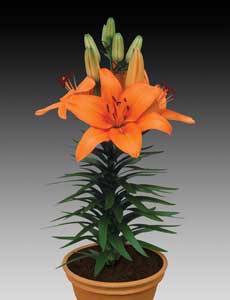10/15/2008
Growing Great Potted Lilies
Frans Roozen

Lilies are among the most popular cut flowers, but they also make excellent potted flowers. Potted Easter lilies have long been a standard floral item, though with a limited season. Today, many growers find that a wide variety of lilies make colorful and profitable products year round. The following are some expert tips from Holland’s International Flower Bulb Center on growing potted lilies successfully.
Best practices
Following some simple best practices to help you succeed with potted lilies:
Choose a good substrate. Use a disease-free, moisture retentive, light-medium substrate with a pH between 6 and 7. Potting compost supplemented with 30% drift sand or perlite (fluorine free) is suitable for use in pots. Add a base dressing of 2 to 3 lbs. of Osmocote 14-14-14 and 2 to 4 lbs. of sulphate of potash-magnesia per yard of mix.
Plant bulbs at the bottom of the pot on a 1⁄2-in. layer of potting compost, If two or more bulbs are planted per pot, the bulb noses should face outward. Top off with potting soil. After planting, ensure that the substrate is thoroughly moist.
Avoid yellow foliage. Yellowing foliage can occur during the growing period. This can result from low light, the habit of the variety, pythium or overly moist conditions.
Harvest at the right time. Pot lilies are ready for market when the lower buds show sufficient color. Shipping time should be kept as short as possible to prevent bud drop as a result of poor light. Lilies definitely should not be shipped at an earlier stage of development due to the increased susceptibility to bud drop.
Avoid storing potted lilies in cold storage. If lilies must be placed in cold storage, make sure it’s for a short time. The minimum temperature should be 41F (5C), both in cold storage and during transport. Asiatic hybrids can be stored at 37F (3C). Although these temperatures don’t stop flower development, lower temperatures can cause insufficient opening of the flower buds when consumers bring the plants home.
Shorter is better
The long stems of cut lilies present no problems for products that are shipped in boxes. Potted lilies, however, are most often shipped on racks by truck, where space is at a premium. For years, the only way to grow shorter lilies was to manipulate the growing environment by a mix of temperature and plant growth regulator treatments. However, results can vary depending on factors such as growing period, substrate, temperature and the natural qualities of various cultivars.
Today, many growers are eliminating variables, controlling costs and going greener by choosing newer cultivars that are already genetically short. Lily Looks is a new line of low-growing Asiatic lilies bred specifically as pot plants. There are currently six color groups available. All produce many buds, are insensitive to leaf scorching and bud withering, need only a short forcing period, and are genetically short.
Frans Roozen is Technical Director, International Flower Bulb Center, Hillegom, the Netherlands.